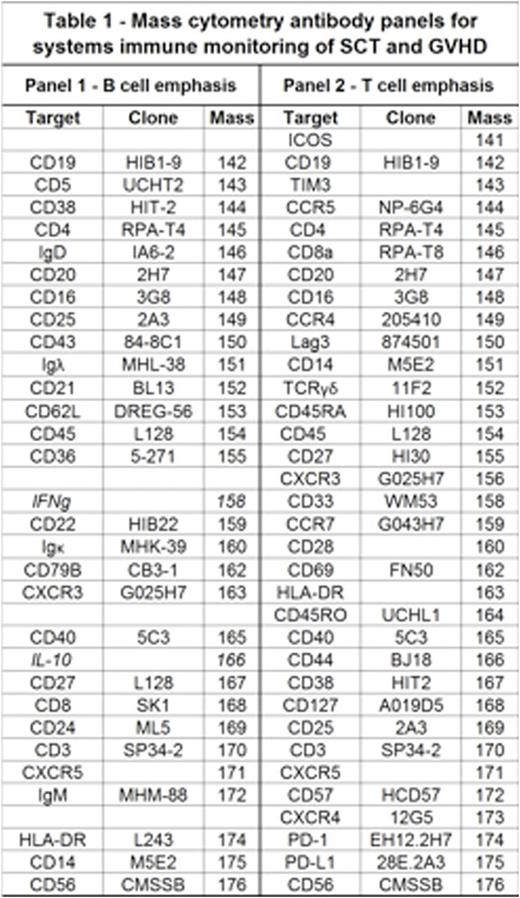Abstract
Introduction: Allogeneic stem cell transplant (SCT) fundamentally alters the immune milieu of an individual and provides a curative treatment for patients with blood cancer. However, a common side effect of SCT is the development of chronic graft versus host disease (cGVHD). Given the growth of new experimental therapeutics for GVHD, a systems immune monitoring approach based on mass cytometry analysis of peripheral blood may provide a robust and minimally invasive way to characterize the post-SCT cGVHD immune environment and systematically track cellular biomarkers of immune status, disease severity, or ongoing treatment responses (Greenplate et al., Euro J Cancer 2016, Kordasti et al., Blood 2016). It may also be possible to identify shifts in the immune milieu or cell signaling that predict treatment responses or stratify risks (Greenplate et al., Cancer Immunol Res 2016). This study tested the feasibility of using mass cytometry peripheral blood analysis in clinical research with the goals of 1) better understanding the post-SCT and cGVHD immune environment and 2) developing a knowledge base for monitoring treatment responses.
Methods: Peripheral blood mononuclear cells (PBMC) were collected with informed consent from cGVHD patients or healthy donors with approval of the local Institutional Review Board (IRB) and in accordance with the Declaration of Helsinki. A total of 88 viably cryopreserved PBMC samples were analyzed from 11 individual patients undergoing extracorporeal photopheresis (ECP) therapy. For each patient, PBMC from 4 clinical timepoints representing pre-ECP and 2, 4, and 6 months post-ECP were characterized with 2 systems immune monitoring antibody panels emphasizing B cells and T cells (Table 1). Staining, data collection using a CyTOF mass cytometer, bead based normalization, and analysis with Cytobank software followed established protocols (Leelatian et al., Methods Mol Bio 2016, Polikowsky et al., J Immunol 2015). Next, cell subsets were algorithmically revealed and characterized by computational tools (Diggins et al., Methods 2015) and patterns in the abundance and phenotype of T, B, NK, and myeloid cell subsets systematically compared to patient clinical features.
Results: Single cell tools revealed profound, abnormal shifts in the peripheral immune environment in individual patients that contrasted with relatively stable immunophenotypes observed in healthy individuals and prior studies. Expected immune changes, such a profound loss of B cells post-treatment with Rituximab, were readily detected by computational tools and expert review. Expression of signaling, activation, and subset identity markers in B and T cell subsets displayed striking variation between patients and was effectively quantified on at least 5 major cell subsets and numerous minor cell subsets (Figure 1). These data highlighted how computational tools paired with high-dimensional mass cytometry can systematically characterize key protein features and cell subsets in complex and heterogeneous diseases including cancer and cGVHD and provided a rationale for ongoing association analyses between cellular subsets and clinical outcomes.
Conclusion: Systems immune monitoring successfully revealed shifts in cell abundance and immunophenotype pre- and post-ECP for patients with cGVHD. These shifts were detected by computational tools and revealed alterations to the immune system following treatment. This study indicates that single cell quantitative analysis is feasible as a clinical research tool to characterize immunotherapy treatment responses, and reveal cellular biomarkers. Integration of such tools in prospective clinical trials is essential to establish and once validated, may augment physician decision making.
Polikowsky:Cytobank: Employment. Greenplate:Cytobank: Consultancy. Jagasia:Therakos: Consultancy. Irish:Cytobank, Inc.: Equity Ownership, Membership on an entity's Board of Directors or advisory committees; Janssen: Research Funding; Incyte: Research Funding.
Author notes
Asterisk with author names denotes non-ASH members.



This feature is available to Subscribers Only
Sign In or Create an Account Close Modal